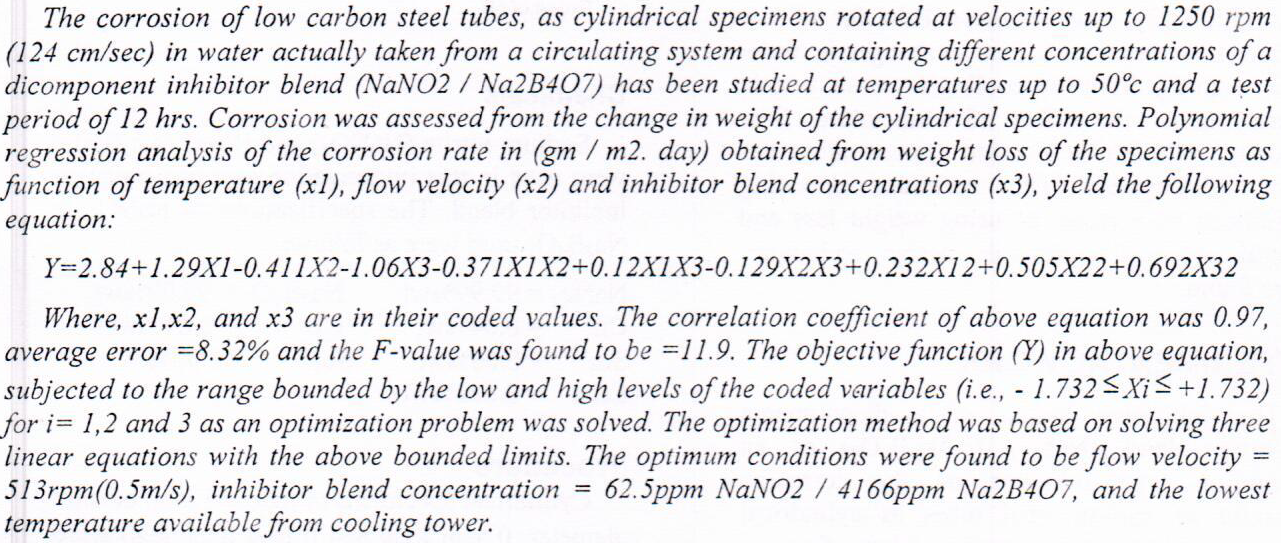
Abstract
In this study, the effect of carboxylic methyl cellulose (CMC), and sodium dodcyl benzene sulfonate (SDBS) as an aqueous solution on the drag reduction was investigated. Different concentrations of (CMC) and (SDBS) such as (50, 100, 150, 200, 250, 300, 350, 400, 450, and 500 ppm) were used to analyze the aqueous solution properties, including surface tension, conductivity, and shear viscosity. The optimum four concentrations (i.e., 50, 100, 200, and 300 ppm) of fluid properties were utilized to find their effect on the drag reduction. Two different PVC pipe diameters (i.e., 1" and 3/4") were used in this work. The results showed that blending CMC with SDBS gives
... Show MoreMany faces are exposed to degradation, discoloration, changes in humidity. The primary objective has improved some properties of hybrid nanocomposites materials that used for restoring of the function maxillofacial prosthesis and improving the esthetic. In the present research different lengths chopped and continuous of ultrahigh molecular weight polyethylene (UHMWPE) fiber was added at selected percentage (0.0, 0.2% and 1%) to polymer blend composite (95%SR /5%PMMA: 0.2% Pomegranate Peels Powder (PPP)) for developing the properties of silicone rubber used for the maxillofacial prosthesis applications. Some mechanical and physical properties were done on the all prepared samples. The results showed that all properties have improved when add
... Show More (7)
(7)
Abstract: Objectives: To investigate the effect of temperature elevation on the bonding strength of resin cement to the zirconia ceramic using fractional CO2 laser. Background: Fractional CO2 laser is an effective surface treatment of zirconia ceramic, as it increases the bonding strength of zirconia to resin cement. Methods: Thirty sintered zirconia discs (10 mm diameter, 2 mm thickness) were prepared and divided to three groups (N=10) and five diffident pulse durations were used in each group (0.1, 0.5, 1, 5 and 10 ms). Group A was treated with 10 W power setting, group B with 20 W and group C with 30 W. During laser irradiation, temperature elevation measurement was recorded for each specimen. Luting cement was bonded to the treated z
... Show MoreThe V2O5 films were deposited on glass substrates which produce using "radio frequency (RF)"power supply and Argon gas technique. The optical properties were investigated by, UV spectroscopy at "radio frequency" (RF) power ranging from 75 - 150 Watt and gas pressure, (0.03, 0.05 and 0.007 Torr), and substrate temperature (359, 373,473 and 573) K. The UV-Visible analysis shows that the average transmittance of all films in the range 40-65 %. When the thickness has been increased the transhumance was decreased from (65-40) %. The values of energy band gap were lowered from (3.02-2.9 eV) with the increase of thickness the films in relation to an increase in power, The energy gap decreased (2.8 - 2.7) eV with an increase in the pressure and
... Show More (3)
(3)
 (1)
(1)
The aim of this study is to understand the effect of addition carbon types on aluminum electrical conductivity which used three fillers of carbon reinforced aluminum at different weight fractions. The experimental results showed that electrical conductivity of aluminum was decreased by the addition all carbon types, also at low weight fraction of carbon black; it reached (4.53S/cm), whereas it was appeared highly increasing for each carbon fiber and synthetic graphite. At (45%) weight fraction the electrical conductivity was decreased to (4.36Scm) and (4.27Scm) for each carbon fiber and synthetic graphite, respectively. While it was reached to maximum value with carbon black. Hybrid composites were investigated also; the results exhibit tha
... Show MoreThis paper presents a computer simulation model of a thermally activated roof (TAR) to cool a room using cool water from a wet cooling tower. Modeling was achieved using a simplified 1-D resistance-capacitance thermal network (RC model) for an infinite slab. Heat transfer from the cooling pipe network was treated as 2-D heat flow. Only a limited number of nodes were required to obtain reliable results. The use of 6th order RC-thermal model produced a set of ordinary differential equations that were solved using MATLAB - R2012a. The computer program was written to cover all possible initial conditions, material properties, TAR system geometry and hourly solar radiation. The cool water supply was considered time
... Show MoreIn this research is to study the influence of the aging heat treatment on the pitting corrosion resistance of martensitic stainless steel (MSS), where a number of specimens from martensitic stainless steel were subjected to solution treatment at 1100 oC for one hour followed by water quenching then aging in the temperatures range (500-750) oC for different holding times (1,5,10,15&20) hr. Accelerated chemical corrosion test and immersion chemical corrosion test were performed on samples after heat treatment. The results of the research showed that the pitting corrosion resistance is significantly affected by the aging temperature. Where found that the aging samples at a temperature of 500 °C have the highest ra
... Show More (3)
(3)
 (1)
(1)
In this research study Hardness (shore D), Water absorption,
Flexural, Impact Test, and Fracture Toughness of polymer nano
composites. The polymer nano composites based on unsaturated
polyester resin reinforced with Kevlar fibers (K.F). The samples are
attended by hand lay – up method according to (Rule mixture) for
various volume fractions of unsaturated polyester resin, fiber and
carbon nanotube. The polyester resin was matrix strengthened with
3% volume fraction from Kevlar fiber and (0.5%, 1%, 1.5%, 2%)
volume fractions of carbon nanotube. The water absorption, hardness
(shore D), flexural test, impact test and toughness fracture properties
were studied. Results showed that the water absorption increas
 (1)
(1)
